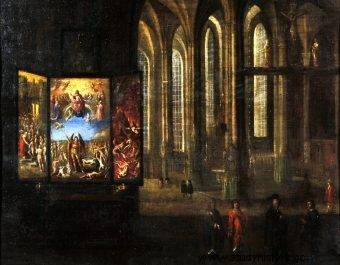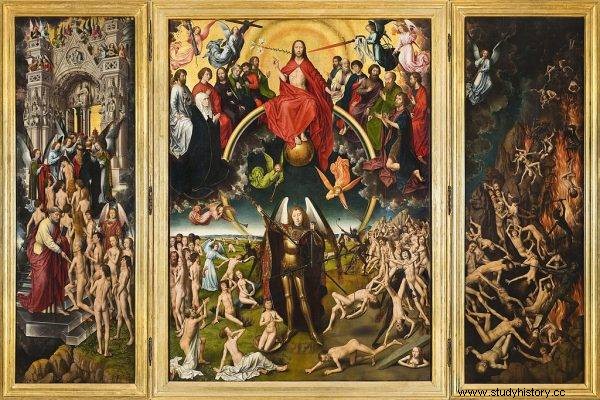This medieval altar is unique not only because of its cultural values. Few works of art can boast such a rich history.
When Angelo di Jacopo Tani decided to fund an altar for the Church of San Bartolomeo in the city of Fiesole, he could not have guessed what a turbulent fate awaited the Last Judgment Triptych. The work of the Bruges artist Hans Memling has made a journey worthy of an adventure novel character.

The work of the Bruges artist Hans Memling has made a journey worthy of an adventure novel character.
No wonder that his story continues to inspire - among others, Mirosław Bujko, the author of the sensational novel "The Last Judgment", whose characters get to know the altar escapade full of turbulence. How did it get to St. Mary's Church in Gdańsk? How many times has it been brought back into place? And why was it exhibited for many years as the work of a completely different painter?
A visionary from Bruges
Hans Memling is considered one of the most important artists of the turn of the Middle Ages and the Renaissance. He was a representative of the Dutch school of painting, using reflections and glare to convey additional content to the audience - as we see it on the polished armor plate of Archangel Michael in the central part of the famous altar.
The triptych - commissioned by Angelo di Jacopo Tani - was written about four years, from 1467 to 1471. Even though the doomsday theme was one of the most used in art at the time, Memling's work is today considered to be one of the finest in its genre.

Few works of art can boast such a rich history.
The founder of the altar, Angelo di Jacopo Tani, was head of the Italian branch of the Medici bank in Bruges. According to the assumptions, the altar was to decorate the Chapel of San Michele in the Church of San Bartolomeo in Fiesole near Florence. Angelo presumably funded Memling's work not only to beautify the church and mark his high social standing. Historians speculate that the altar was also a kind of "gift" for the higher powers, along with a previously written will to protect the banker in case of misfortune on the way to London - a new job.
There are also hypotheses that by funding the altar, the man wanted to ease the conflict with his rival Tommaso Portinari. The finished artwork was shipped by sea to its destination… but never reached!
Robbery at sea
When the Triptych of the Last Judgment was sailing on board the galleon "Saint Matthew" towards the coast of England, the Anglo-Hanseatic War had been going on for two years on the sea. The ship carrying the work of art was leased by Tommaso Portinari. It was unfortunate that the galleon was noticed by the crew of the caravel "Piotr z Gdańsk" led by Paweł Beneke. On April 27, 1473, a much more powerful Hanseatic League unit attacked and sacked "Saint Matthew" .

The article was inspired by Mirosław Bujko's book "The Final Judgment", which has just been published by the Sonia Draga publishing house. Buy now
It quickly turned out that the cargo holds of the ship sailing towards England were full of valuable goods:fabrics, canvases, leathers, silk upholstery and alum - Portinari's treasures. The raiders also found an altar by Hans Memling and gave it, along with the rest of the gains, to the Gdańsk owners of "Piotr of Gdańsk", who in turn handed it over to St. Mary's Church in Gdańsk. The audacious move caused a great stir - so great that Pope Sixtus IV himself intervened. However, it did not bring any results, and the altar remained in Gdańsk until 1807.Court in war
With the beginning of the nineteenth century and the advent of the Napoleonic wars, thanks to the actions of Dominiqua Vivant Denon - a French aristocrat, artist, diplomat and traveler - the Triptych found its way to the Louvre as a spoil of war. Interestingly, the identity of the author of the work has been forgotten and it was exhibited in Paris as an altar to ... Jan van Eyck.
Ten years later, the Triptych was restored to Berlin. The Berlin Academy of Arts was interested in keeping the unique "gains" - unlike the representatives of Gdańsk. They even rejected an offer to exchange for the Sistine Madonna Rafaela with three scholarships for emerging artists! Eventually, the altar returned to its place, where it remained until the end of World War II. During this period, it was also possible to establish that it was not van Eyck, but Hanz Memling, who was behind the creation of the work, thanks to the work of Heinrich Gustav Hotho, an expert in Eyck work.

During this period, it was also possible to establish that it was not van Eyck who was behind the creation of the work, but Hanz Memling
Unfortunately, the "adventures" of the unfortunate altar did not end there. Soon it was among the spoils of war taken to the Third Reich, and then fell into the hands of the Red Army. It was exhibited in the Hermitage.
In 1956, the Triptych of the Last Judgment became part of the Exhibition of Works of Art Secured by the USSR at the National Museum in Warsaw, and in 1958 it finally returned to Gdańsk. This time, however, it was not exhibited in St. Mary's Church (you can see a copy here), but in the Pomeranian Museum, to which it was donated by the Evangelical Virgin Mary parish in the 1930s. Currently, it can be admired at the National Museum in Gdańsk.
Inspiration:
The article was inspired by Mirosław Bujko's book "The Final Judgment", which has just been published by the Sonia Draga publishing house.
